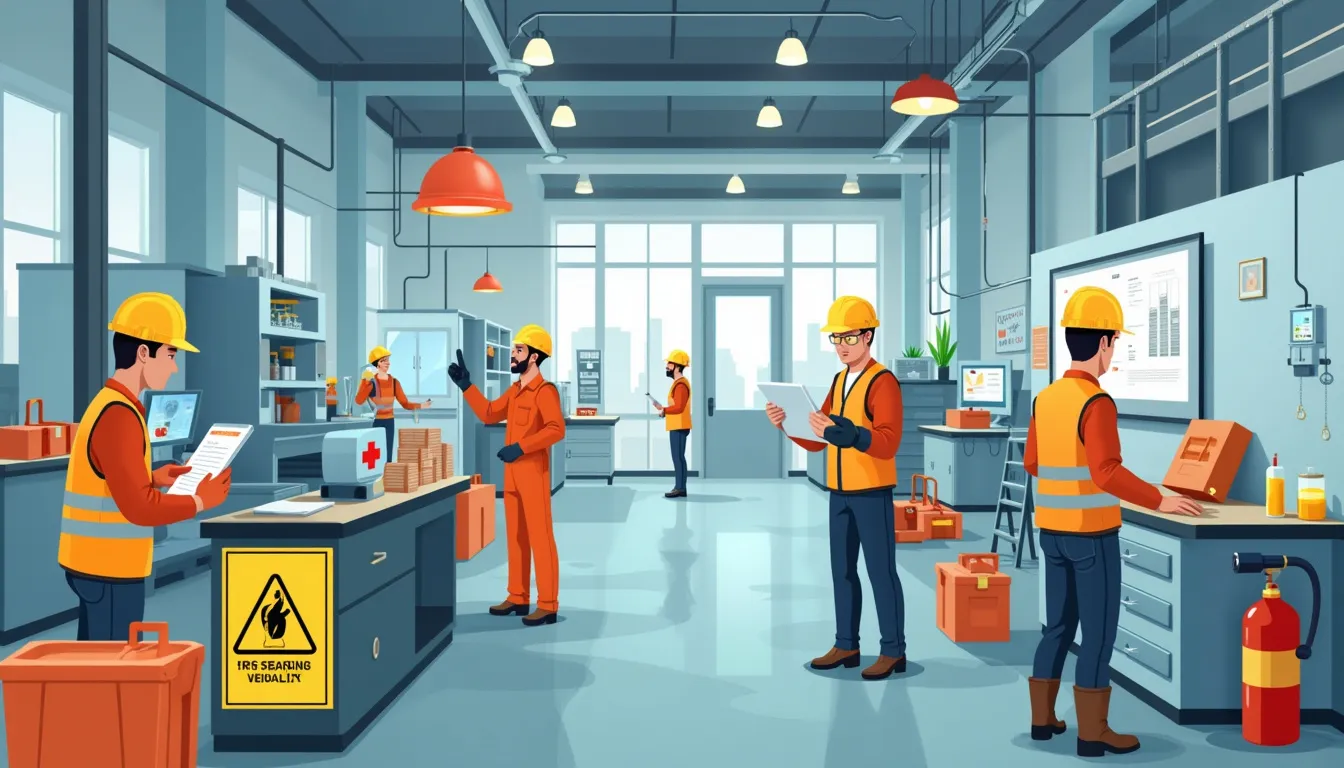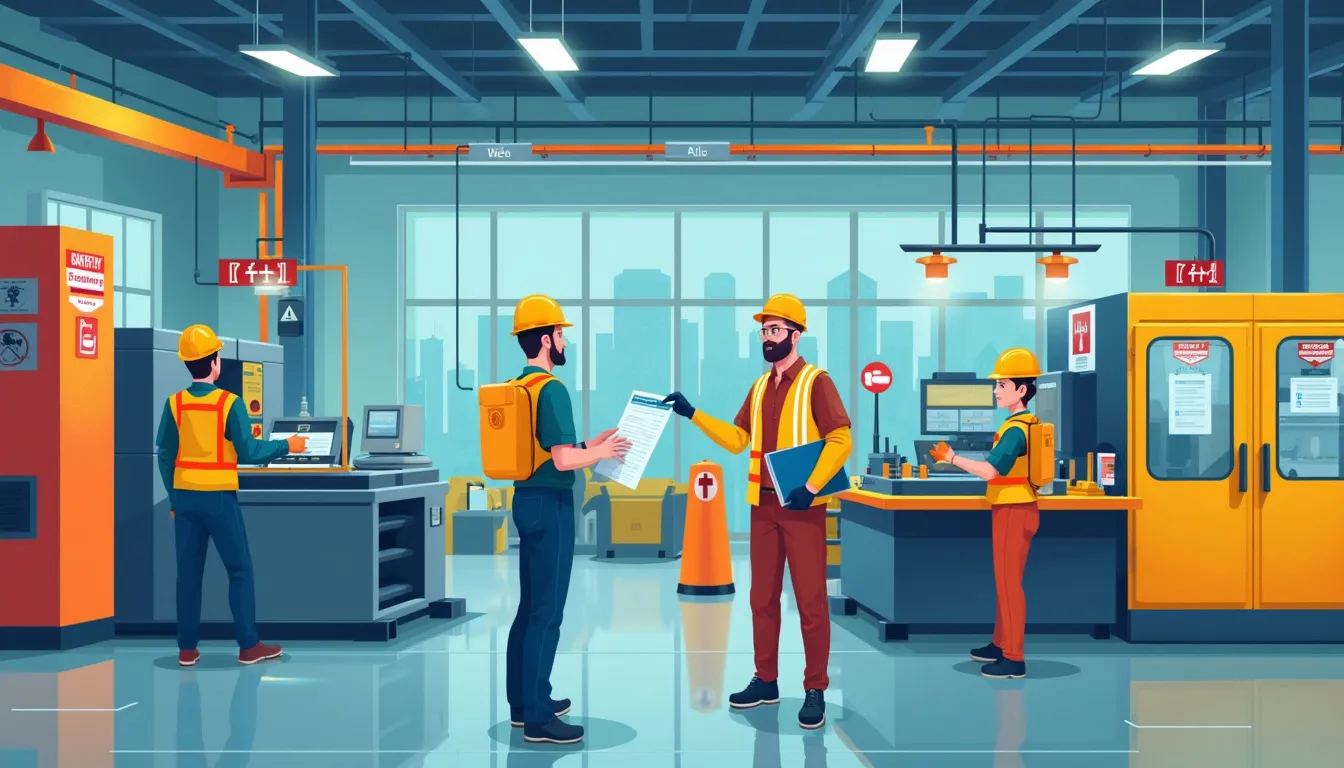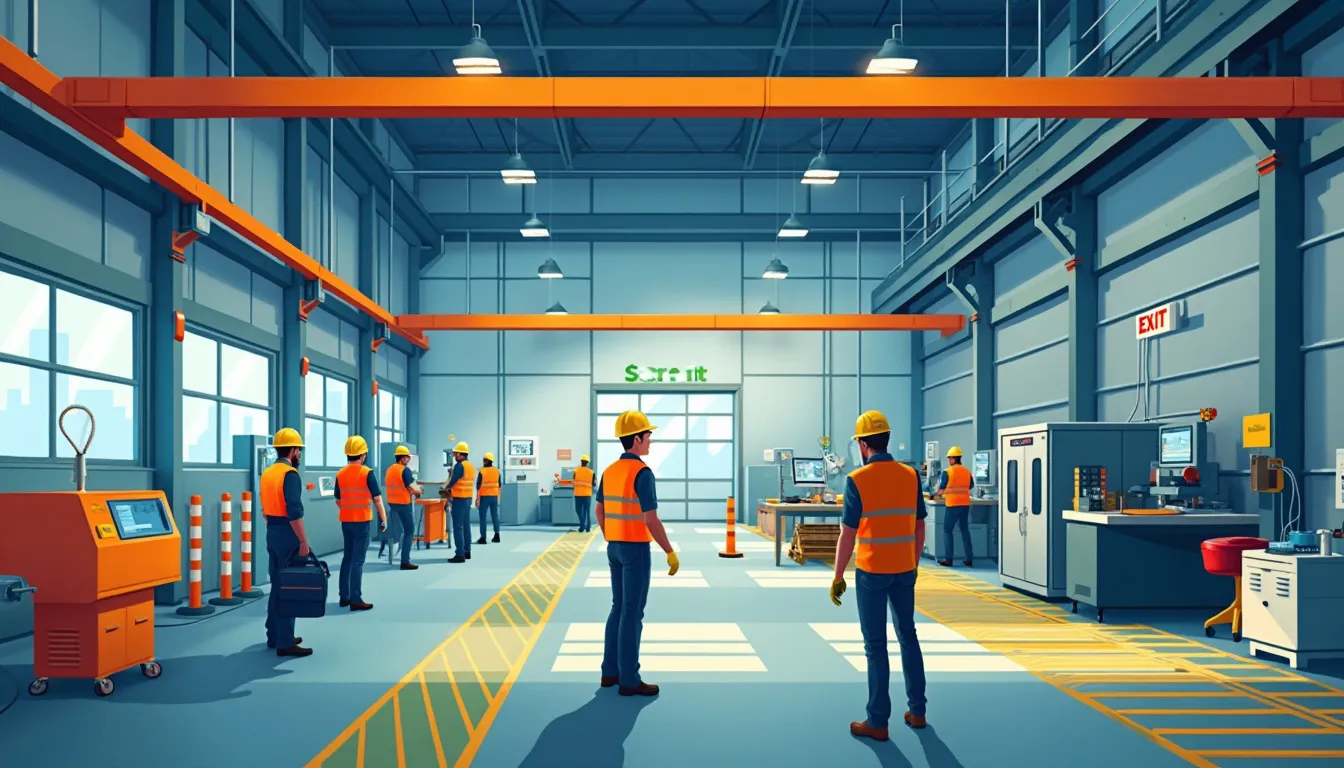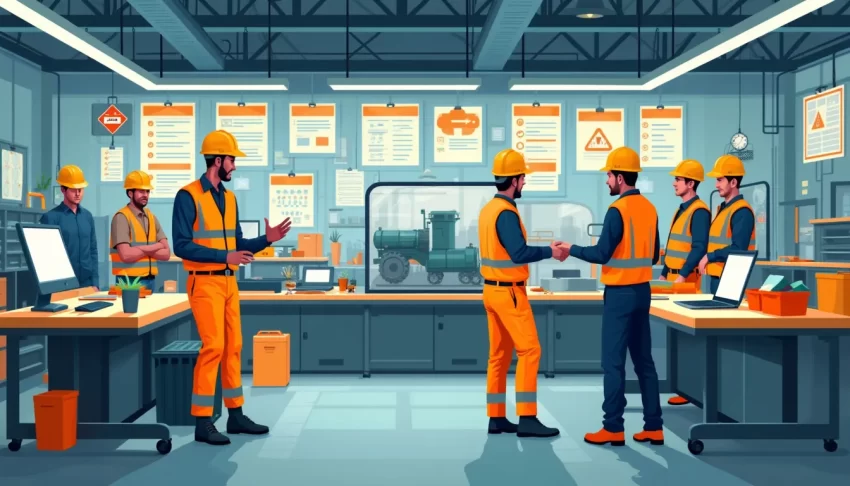In today’s fast-paced industrial landscape, the importance of implementing robust industrial safety protocols cannot be overstated. Industrial safety protocols are systematic guidelines designed to safeguard the health and well-being of workers while minimizing risks. These essential measures help prevent accidents, manage hazards, and ensure a smooth operational flow in various industrial settings. From identifying potential risks to developing comprehensive safety management systems, these protocols form the backbone of a safe work environment. Regulatory bodies and standards play a crucial role in defining and enforcing these protocols, ensuring that industries adhere to strict safety benchmarks. As we delve deeper into understanding and implementing industrial safety protocols, we will explore key components like hazard identification, risk assessment, and the crucial role of worker training. Moreover, implementing these protocols requires not only meticulous planning and execution but also leveraging modern technology and equipment. Continuous monitoring and improvement practices further ensure that safety standards evolve with emerging challenges. Through real-world case studies and best practices, we uncover the success stories and valuable lessons learned in the realm of industrial safety. Join us as we navigate the complexities of industrial safety protocols, paving the way for safer and more efficient industrial operations.
Introduction to Industrial Safety Protocols
Definition and Importance of Industrial Safety Protocols
Industrial safety protocols are meticulously designed guidelines and practices intended to ensure the safety of workers, equipment, and the environment in industrial settings. These protocols are indispensable for mitigating risks associated with industrial operations, which can range from machinery malfunctions to hazardous material spills. Without robust industrial safety protocols, the likelihood of workplace accidents, injuries, and even fatalities significantly increases. Beyond the moral imperative of safeguarding human life, these protocols are also crucial for maintaining operational efficiency and avoiding costly disruptions.
Overview of Key Safety Measures in Industrial Settings
Key safety measures are the bedrock of effective industrial safety protocols. These measures encompass a variety of strategies and practices designed to preemptively address potential hazards. Personal Protective Equipment (PPE) such as helmets, gloves, and protective eyewear form the first line of defense. Additionally, the implementation of safety signage and labels helps in alerting workers to potential dangers, ensuring that everyone is consistently reminded of the risks around them. Emergency preparedness drills, including fire and evacuation drills, further bolster a site’s readiness to tackle unexpected incidents. Finally, engineering controls such as ventilation systems and safety interlocks on machinery play a crucial role in safeguarding the work environment.
The Role of Regulatory Bodies and Standards
Regulatory bodies are pivotal in the formulation and enforcement of industrial safety protocols. Organizations such as the Occupational Safety and Health Administration (OSHA) in the United States, and the International Organization for Standardization (ISO) globally, establish comprehensive guidelines that industries must follow to ensure worker safety. These entities develop standards based on extensive research and field studies, setting benchmarks for safety practices that transcend national boundaries. Compliance with these standards is not just a legal obligation but a testament to an organization’s commitment to maintaining a safe and productive workplace. Failure to adhere to these regulations can result in severe penalties, including fines and operational shutdowns, underscoring the necessity of stringent compliance.
In summary, industrial safety protocols are essential components of a well-functioning industrial operation, encapsulating the principles of hazard prevention, regulatory compliance, and the continuous improvement of workplace safety standards. The importance of these protocols cannot be overstated, as they serve as the cornerstone of a safe, efficient, and legally compliant industrial environment.
Safetyology – Get The Book Today!

Key Components of Effective Industrial Safety Protocols
Hazard Identification and Risk Assessment
One foundational element of effective industrial safety protocols is the meticulous identification of hazards and the subsequent assessment of associated risks. This process, an integral part of any safety management system, entails a systematic look at the workplace to identify potential dangers that could cause harm to employees. Once hazards are identified, a risk assessment evaluates the potential impact and likelihood of these dangers transpiring, fostering a proactive approach to mitigating them.
Industrial safety protocols hinge on this duo—hazard identification and risk assessment—as their primary data-gathering and problem-solving mechanisms. Tools like job safety analysis (JSA) and hazard and operability studies (HAZOP) are employed to enhance this process. Regularly updated, these evaluations ensure that any changes in operations, new equipment, or alterations in workflow are thoroughly considered and that risks are promptly addressed.
Safety Management Systems and Procedures
The implementation and maintenance of Safety Management Systems (SMS) form the backbone of robust industrial safety protocols. SMSs serve as comprehensive frameworks that integrate safety into every facet of the industrial operation. These systems generally include:
– **Policy Development**: Clear, written safety policies that outline the organization’s commitment to maintaining a safe working environment.
– **Setting Objectives and Targets**: Safety goals that are Specific, Measurable, Achievable, Relevant, and Time-bound (SMART).
– **Documentation and Record-Keeping**: Meticulous records of safety audits, inspections, incident reports, and corrective actions taken.
– **Compliance Monitoring**: Ensuring adherence to internal policies as well as external regulatory requirements.
Effective procedures drive these systems, spelling out step-by-step processes for performing tasks safely, managing emergencies, and reporting incidents. These procedures should be dynamic, evolving based on lessons learned, technological advances, and regulatory updates.
Training and Competency Requirements for Workers
No industrial safety protocol can be entirely effective without a well-trained and competent workforce. Training and competency requirements ensure that all employees possess the necessary knowledge and skills to perform their duties safely. Training programs should be continuous and iterative, combining theoretical knowledge with practical, hands-on experiences.
Key elements of an effective training program include:
– **Initial Orientation**: Introduction to the company’s safety culture, policies, and procedures for new hires.
– **Job-Specific Training**: Focused training that addresses the unique risks and safety measures pertinent to specific roles or tasks.
– **Emergency Response Training**: Preparing workers for potential emergencies with drills and simulations.
– **Regular Refresher Courses**: Keeping skills and knowledge up-to-date through periodic training sessions.
Moreover, a robust evaluation system should be in place to assess the effectiveness of training programs. Competency assessments, practical exams, and feedback mechanisms help ensure that employees not only receive training but also understand and can apply the safety knowledge in real-world scenarios.
The continuous development of worker competency is crucial. This includes not only technical skills but also soft skills such as communication, teamwork, and situational awareness—all vital for fostering a culture of safety and compliance throughout the organization.
In conclusion, the key components of effective industrial safety protocols are interlinked and critical to maintaining a safe and compliant industrial environment. From thorough hazard identification and comprehensive safety management systems to rigorous training and competency requirements, each element plays a pivotal role in safeguarding human lives and ensuring operational efficiency. Implementing these components meticulously can significantly reduce the incidence of workplace injuries and enhance overall productivity.
Safetyology – Get The Book Today!

Implementing Industrial Safety Protocols in the Workplace
Industrial safety protocols are the backbone of any safe working environment. To ensure they are not just a set of guidelines gathering dust on a shelf, companies need a strategic approach to implementation. But how do you turn these essential protocols into everyday practice? Let’s walk through the essential steps and best practices for integrating industrial safety protocols into the workplace effectively.
Steps for Developing and Enforcing Safety Protocols
1. Start with a Safety Audit: Before you can implement or enhance any industrial safety protocols, conduct a comprehensive safety audit. This involves assessing the current safety landscape, identifying high-risk areas, and reviewing existing safety procedures. Use this data to create a tailored safety plan that addresses specific risks within your industrial setting.
2. Develop Clear and Practical Policies: Once you have a clear understanding of the risks, develop clear, practical, and detailed safety policies. Ensure these policies are in line with regulatory requirements and industry standards. The protocols should address common hazards specific to your industry, such as chemical handling, machinery operation, or working at heights.
3. Engage Leadership and Employees: For safety protocols to be effective, buy-in from both leadership and employees is crucial. Leaders must champion safety initiatives and set examples, while employees must be involved in the creation and review of safety protocols. This cultivates a culture of safety and ensures everyone understands the importance of adhering to these protocols.
4. Effective Communication and Training: Communication is key to successful implementation. Clearly communicate the new or updated protocols to all employees through meetings, emails, and signage in common areas. Follow up with comprehensive training sessions to ensure everyone is competent and confident in executing the necessary safety measures.
5. Enforce with Documentation and Accountability: Document every step of the protocol implementation process. This includes recording attendance at safety training sessions, acknowledgment of policy understanding, and regular safety inspections. Having a documented trail ensures accountability and makes it easier to track compliance and areas needing improvement.
Integrating Technology and Safety Equipment
In the modern industrial landscape, leveraging technology and advanced safety equipment can significantly enhance the effectiveness of safety protocols. Here’s how technology can be seamlessly integrated:
1. Automated Safety Systems: Automated safety systems such as fire suppression systems, gas leak detectors, and emergency shut-off systems can provide instant responses to hazardous situations, reducing the reliance on human intervention and minimizing response times.
2. Wearable Safety Technology: Wearables such as smart helmets, wristbands, and vests can monitor workers’ vital signs, detect environmental hazards, and send alerts if a worker is in danger. These wearables also facilitate easier incident reporting and faster emergency response.
3. Safety Management Software: Implementing safety management software can streamline safety operations. These platforms help manage compliance, training schedules, incident reporting, and risk assessments, providing a centralized system for tracking and improving safety practices.
4. Drones and Robotics: Drones can be used for aerial inspections of difficult-to-reach areas, while robots can handle hazardous materials, reducing the need for human exposure to potential harms. They provide real-time data and enhance safety oversight in challenging environments.
Continuous Monitoring and Improvement Practices
Implementing industrial safety protocols is not a one-time event but an ongoing commitment. Continuous monitoring and improvement are essential to maintain a safe workplace. Here’s how to ensure protocols evolve with the workplace:
1. Regular Safety Audits and Inspections: Conduct regular safety audits to assess the effectiveness of current protocols. Scheduled inspections should be complemented with unscheduled checks to gauge the real-time application of safety measures. This helps identify new hazards or lapses in compliance.
2. Incident Reporting and Analysis: Encourage a transparent incident reporting culture. Analyze all reported incidents, near-misses, and safety observations to understand root causes, and use this data to improve existing protocols. Sharing the lessons learned from these analyses can prevent future occurrences.
3. Feedback Loop: Establish a feedback loop involving employees at all levels. Workers on the ground often provide the best insights into practical issues and potential improvements. Regular feedback sessions can unearth valuable suggestions and foster a collaborative effort towards enhancing safety.
4. Update Training and Safety Protocols: Safety protocols must evolve with technological advancements and regulatory changes. Regularly update training programs and protocols to incorporate the latest safety practices and equipment. Continuous education ensures employees remain aware of the best available safety measures.
5. Performance Metrics and Rewards: Track safety performance using key metrics such as the number of incidents, compliance rates, and safety audit findings. Recognize and reward teams or individuals who demonstrate exceptional commitment to maintaining a safe workplace. This not only motivates compliance but also reinforces a culture where safety is a shared priority.
By following these steps, integrating advanced technology, and committing to continuous improvement, companies can transform industrial safety protocols from theoretical guidelines into practical, effective measures that protect workers and enhance operational efficiency. It’s not just about compliance; it’s about creating a sustainable, safety-first ethos that permeates every level of the organization.
Safetyology – Get The Book Today!

Case Studies and Best Practices in Industrial Safety
Examples of Successful Safety Protocol Implementations
One of the most riveting examples of effective industrial safety protocols is seen in the oil and gas industry. Companies like Shell and BP have established comprehensive safety programs that focus on preventing accidents through rigorous hazard assessments, employee training, and the adoption of advanced monitoring technologies. Shell’s “Goal Zero” initiative, for instance, aims for zero harm and no leaks across their operations, which has significantly reduced workplace incidents and environmental impacts. The key takeaway here is a relentless pursuit of safety that transcends compliance and permeates the corporate culture.
Additionally, the manufacturing giant 3M has effectively implemented safety protocols that drastically decrease workplace injuries. Their system focuses on preventive measures, employee engagement, and continual improvement. Through robust safety training programs, real-time risk assessments, and the integration of IoT devices for machinery monitoring, 3M not only ensures compliance with industrial safety protocols but also pioneers innovations that set industry benchmarks.
Lessons Learned from Industrial Safety Incidents
Unfortunately, not all industries can boast such success stories. The 2010 Deepwater Horizon disaster serves as a somber reminder of lapses in industrial safety protocols. An inadequate safety culture, poor safety management systems, and ignored hazards contributed to this catastrophic event. The aftermath led to a massive overhaul in industry practices, emphasizing the importance of a proactive safety culture, stringent regulatory compliance, and the need for robust emergency response plans.
Another notable example is the 2013 Rana Plaza factory collapse in Bangladesh, highlighting the dire consequences of neglecting safety standards. Poor building conditions, lack of safety protocols, and overt negligence resulted in over 1,100 deaths. This tragedy instigated global reforms in industrial safety protocols, underscoring the necessity of rigorous safety inspections, ethical manufacturing practices, and international collaboration to enforce safety standards.
Future Trends and Innovations in Industrial Safety Protocols
As industries evolve, so do the strategies for managing industrial safety protocols. The future holds significant potential for advancements that will make workplaces safer and more efficient. One promising trend is the integration of artificial intelligence (AI) and machine learning algorithms to predict and prevent safety incidents. By analyzing vast amounts of data from past incidents and real-time sensor inputs, AI systems can identify potential hazards before they lead to accidents.
Furthermore, wearable technology is making waves in industrial safety. Smart helmets and gloves equipped with sensors can monitor workers’ vital signs and environmental conditions, providing real-time feedback and alerting them to potential dangers. This proactive approach ensures that safety is not merely reactive but embedded into everyday operations.
Another noteworthy innovation is the use of virtual reality (VR) for safety training. VR simulations offer immersive training experiences that prepare employees for emergency scenarios in a controlled environment. This hands-on approach significantly enhances their ability to respond effectively to real-world incidents.
Lastly, the concept of Safety 4.0, inspired by Industry 4.0, emphasizes a holistic integration of digital technologies into industrial safety protocols. This includes advanced robotics, IoT, and big data analytics, all harmonized to create smarter, safer industrial environments. By tapping into these technologies, companies can continuously monitor safety performance, predict potential risks, and swiftly implement corrective measures.
Adopting and adapting these future-oriented strategies can not only improve current safety standards but also pave the way for an era where industrial accidents become a rarity. This proactive and innovative approach to industrial safety protocols will undoubtedly save lives, reduce costs, and enhance productivity across various sectors.
In conclusion, understanding and implementing industrial safety protocols require more than mere adherence to regulations; it demands a commitment to a safety-first culture, continuous innovation, and learning from past failures. By examining successful implementations, acknowledging lessons from past incidents, and embracing future trends, industries can navigate the complexities of workplace safety with confidence and foresight.
In conclusion, understanding and implementing industrial safety protocols is not just a regulatory obligation but a critical element for safeguarding lives and ensuring operational continuity. By recognizing the importance of industrial safety protocols, industries can create a safer working environment that mitigates risks and prevents accidents. Key components such as hazard identification, risk assessment, safety procedures, and proper training are the bedrock of any effective safety strategy.
Implementing these protocols requires a methodical approach, integrating both proven strategies and modern technologies to keep up with ever-evolving industrial landscapes. Look towards continuous improvement and regular monitoring to adapt and fine-tune safety measures. Real-world examples and case studies showcase the efficacy of well-executed safety protocols and offer valuable insights into both successes and areas that need attention.
Embrace the lessons learned from past incidents and stay abreast of future innovations to stay ahead. The commitment to industrial safety protocols is a commitment to every worker’s well-being and the sustainable success of industrial operations. By embedding these practices into the very fabric of your organizational culture, you are investing in a future where safety and productivity go hand in hand.
Safetyology – Get The Book Today!
Support Us: Check out our recommended products on Amazon.

